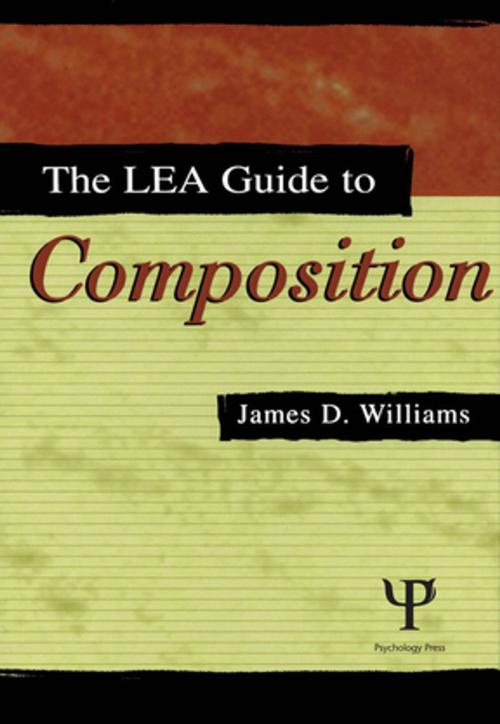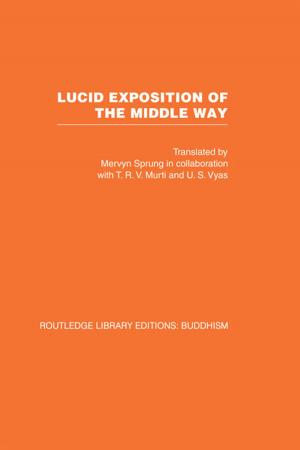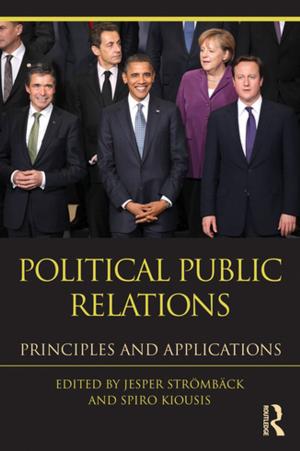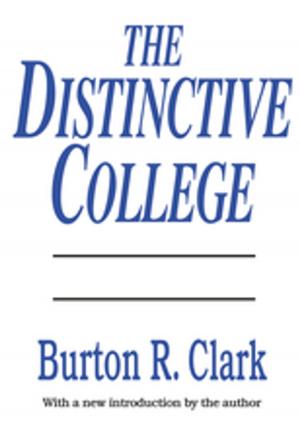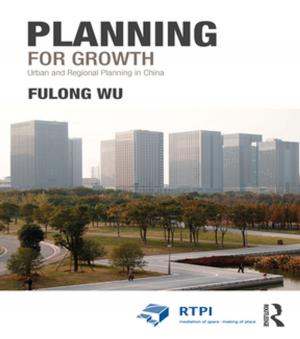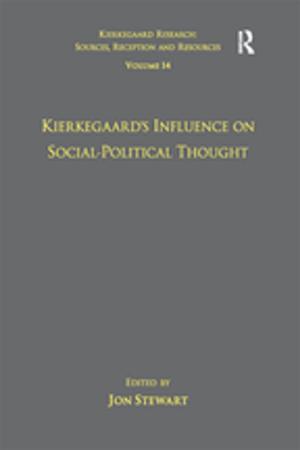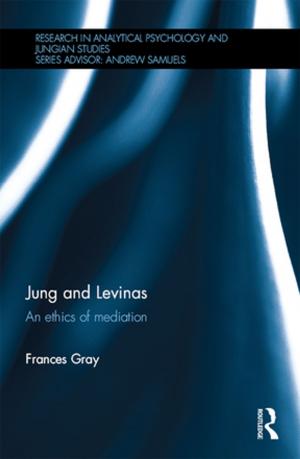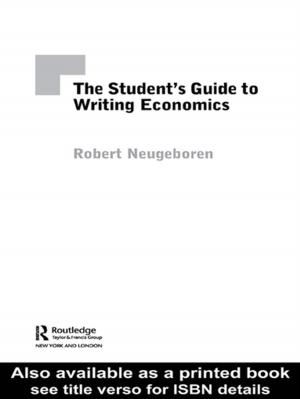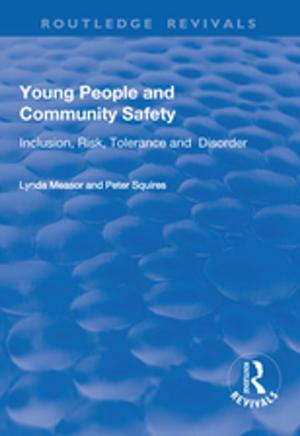The Lea Guide To Composition
Nonfiction, Reference & Language, Language Arts, Writing & Publishing, Composition & Creative Writing| Author: | James D. Williams | ISBN: | 9781135672782 |
| Publisher: | Taylor and Francis | Publication: | April 11, 2005 |
| Imprint: | Routledge | Language: | English |
| Author: | James D. Williams |
| ISBN: | 9781135672782 |
| Publisher: | Taylor and Francis |
| Publication: | April 11, 2005 |
| Imprint: | Routledge |
| Language: | English |
The LEA Guide to Composition is firmly based on research into how people learn to write and draws on the most significant strategies and techniques in composition studies. But this text is not just about the act of writing. It is about using writing as a vehicle for learning--about the world, about the academy, about oneself. The focus is on writing as a means of interpretation. The emphasis throughout is on encouraging reflection and developing critical thinking skills. Although the text suggests ways of teaching that reflect knowledge about how people most easily learn to become competent writers, it is specifically designed to allow for numerous approaches to teaching composition. Instructors will value this flexibility.
This text is finely tuned to the needs and interests of today's composition students and teachers. Classroom tested at various universities over a four-year period to refine and improve its effectiveness, the Guide is distinguished by a range of carefully crafted instructional features:
*Reading-Writing Connection. An extensive selection of fresh, thought-provoking, professional work allows students to internalize models and acquire appropriate genre familiarity. Student papers are included to illustrate how others have responded to real writing tasks similar to those the readers of this book will face.
*Critical Reading and Thinking. Numerous reading selections are thoroughly analyzed to provide models of close, critical reading. Critical Reading Guides, provided for some selections, draw students in by asking rhetorical questions that develop critical thinking skills and better understanding of how the authors produced key effects.
*Diverse Voices. Specially designed writing activities encourage students who are non-native speakers of English, or who come from non-mainstream cultural backgrounds, to share their perspectives with the entire class.
*Writing Activities. More than 60 writing activities of various types are included, suitable for students with a range of writing experience. Many of these are short assignments that are linked to longer ones, which allows students to build their skills sequentially, adding new skills as old ones are practiced and mastered.
*Writing Guides. Based on years of teaching experience, these guides provide detailed information and concrete, practical advice about how to succeed on selected assignments in each chapter.
*Group Activities. Selected writing assignments include collaborative workshop activities that prompt students to engage in a variety of group efforts that enhance the writing process. As a result, group work progresses with a clear purpose and well-defined goals, leading to more student involvement and, ultimately, better writing.
*Application of Key Ideas. Writing Assignments, Writing Guides, and Critical Reading Guides are complemented by activities that allow students to practice using important concepts discussed in the text that progress with a clear purpose and well-defined before they begin an actual assignment.
*Journal Entries. Prompts throughout the text are included to increase the amount of writing students do, to enhance reflection and critical thinking, and to engage students in reflecting on and making connections between college and their lives outside of class.
*Handbook. The handbook provides basic information about the form and function of language. It focuses on the usage conventions that are a crucial part of academic writing. In addition, it covers differences and similarities in the specific conventions that govern writing in the humanities, social sciences, and science. The documentation formats for these three major divisions of the undergraduate curriculum are described in detail, with full-length student papers to illustrate the formats in context.
An Instructor's Manual is available with this text, upon adoption.
The LEA Guide to Composition is firmly based on research into how people learn to write and draws on the most significant strategies and techniques in composition studies. But this text is not just about the act of writing. It is about using writing as a vehicle for learning--about the world, about the academy, about oneself. The focus is on writing as a means of interpretation. The emphasis throughout is on encouraging reflection and developing critical thinking skills. Although the text suggests ways of teaching that reflect knowledge about how people most easily learn to become competent writers, it is specifically designed to allow for numerous approaches to teaching composition. Instructors will value this flexibility.
This text is finely tuned to the needs and interests of today's composition students and teachers. Classroom tested at various universities over a four-year period to refine and improve its effectiveness, the Guide is distinguished by a range of carefully crafted instructional features:
*Reading-Writing Connection. An extensive selection of fresh, thought-provoking, professional work allows students to internalize models and acquire appropriate genre familiarity. Student papers are included to illustrate how others have responded to real writing tasks similar to those the readers of this book will face.
*Critical Reading and Thinking. Numerous reading selections are thoroughly analyzed to provide models of close, critical reading. Critical Reading Guides, provided for some selections, draw students in by asking rhetorical questions that develop critical thinking skills and better understanding of how the authors produced key effects.
*Diverse Voices. Specially designed writing activities encourage students who are non-native speakers of English, or who come from non-mainstream cultural backgrounds, to share their perspectives with the entire class.
*Writing Activities. More than 60 writing activities of various types are included, suitable for students with a range of writing experience. Many of these are short assignments that are linked to longer ones, which allows students to build their skills sequentially, adding new skills as old ones are practiced and mastered.
*Writing Guides. Based on years of teaching experience, these guides provide detailed information and concrete, practical advice about how to succeed on selected assignments in each chapter.
*Group Activities. Selected writing assignments include collaborative workshop activities that prompt students to engage in a variety of group efforts that enhance the writing process. As a result, group work progresses with a clear purpose and well-defined goals, leading to more student involvement and, ultimately, better writing.
*Application of Key Ideas. Writing Assignments, Writing Guides, and Critical Reading Guides are complemented by activities that allow students to practice using important concepts discussed in the text that progress with a clear purpose and well-defined before they begin an actual assignment.
*Journal Entries. Prompts throughout the text are included to increase the amount of writing students do, to enhance reflection and critical thinking, and to engage students in reflecting on and making connections between college and their lives outside of class.
*Handbook. The handbook provides basic information about the form and function of language. It focuses on the usage conventions that are a crucial part of academic writing. In addition, it covers differences and similarities in the specific conventions that govern writing in the humanities, social sciences, and science. The documentation formats for these three major divisions of the undergraduate curriculum are described in detail, with full-length student papers to illustrate the formats in context.
An Instructor's Manual is available with this text, upon adoption.
